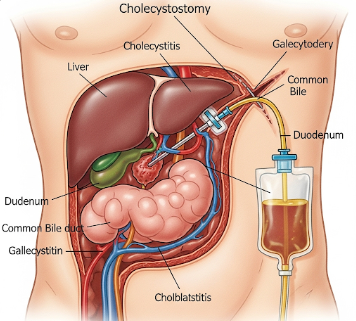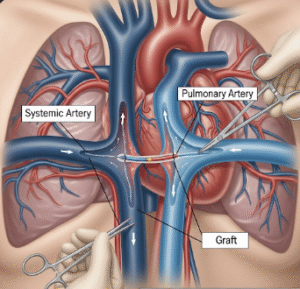Overview
Cholecystostomy is a medical procedure that involves creating an opening in the gallbladder to drain its contents, usually bile or pus, in cases of acute cholecystitis or gallbladder infection. This procedure is often used when patients cannot undergo immediate gallbladder removal (cholecystectomy) due to medical instability or high surgical risk.
In South Korea, cholecystostomy is performed in advanced interventional radiology or surgical units using image-guided techniques to ensure safety, precision, and minimal invasiveness. Hospitals provide comprehensive monitoring and follow-up to manage gallbladder conditions effectively before definitive surgery if needed.
What is Cholecystostomy?
Cholecystostomy is the placement of a drainage tube into the gallbladder to relieve obstruction, infection, or inflammation.
Indications include:
- Severe acute cholecystitis in patients unfit for surgery
- Gallbladder empyema (pus accumulation)
- Obstructed gallbladder due to stones or tumors
- Temporary relief before planned elective cholecystectomy
Types of cholecystostomy:
- Percutaneous cholecystostomy: Image-guided tube insertion through the skin (most common).
- Surgical cholecystostomy: Open or laparoscopic drainage in select cases.
Purpose:
- Relieve pain, infection, and biliary obstruction
- Stabilize patients before definitive gallbladder surgery
- Prevent life-threatening complications like sepsis or perforation
What are the Benefits?
Cholecystostomy provides several therapeutic benefits:
✔ Immediate relief from gallbladder pain and infection.
✔ Stabilizes high-risk patients who cannot undergo surgery immediately.
✔ Minimally invasive with image-guided techniques.
✔ Reduces risk of gallbladder rupture or severe sepsis.
✔ Can serve as a bridge to elective cholecystectomy.
Procedure Details
1) How should I prepare for Cholecystostomy?
- Medical evaluation: Blood tests, liver function tests, imaging (ultrasound or CT scan).
- Medication review: Adjustments may be needed for anticoagulants or other medications.
- Informed consent: Discussion of procedure, benefits, risks, and post-procedure care.
- Fasting: Usually recommended for several hours before the procedure.
- Support plan: Ensure someone is available for transport and post-procedure monitoring.
South Korean hospitals provide personalized pre-procedure assessment to ensure safety and optimal outcomes.
2) What happens during Cholecystostomy?
- Anesthesia: Local anesthesia with mild sedation is commonly used.
- Image guidance: Ultrasound or CT is used to visualize the gallbladder and guide tube placement.
- Drain insertion: A thin catheter is inserted through the abdominal wall into the gallbladder.
- Fluid drainage: Bile or pus is drained to relieve infection and obstruction.
- Secure placement: The tube is fixed to the skin, allowing continuous drainage and monitoring.
- Duration: The procedure typically takes 30–60 minutes.
Korean interventional radiologists emphasize precision, minimal discomfort, and safety, especially for critically ill or elderly patients.
3) What happens after Cholecystostomy?
- Immediate post-procedure: Mild discomfort at the insertion site; tube output is monitored.
- Hospital stay: Often 1–3 days depending on infection severity and patient stability.
- Tube care: Instructions for keeping the drainage tube clean and preventing dislodgement.
- Follow-up imaging: Ensures proper tube placement and infection resolution.
- Definitive surgery: Many patients undergo elective cholecystectomy once stabilized.
Risks / Benefits
Potential Risks:
- ➤ Bleeding at insertion site
- ➤ Infection or abscess formation
- ➤ Bile leakage into the abdominal cavity
- ➤ Tube displacement or blockage
- ➤ Rare injury to surrounding organs
Major Benefits:
- ✔ Rapid relief from gallbladder infection or obstruction
- ✔ Stabilizes high-risk patients for future surgery
- ✔ Minimally invasive and image-guided
- ✔ Reduces risk of gallbladder perforation and sepsis
- ✔ Widely performed with high success rates in South Korean hospitals
Recovery and Outlook
- First few days: Tube output is monitored; mild pain or discomfort is managed with medications.
- 1–2 weeks: Infection usually resolves, and patients can resume basic daily activities.
- Long-term: Tube may remain for several weeks until elective cholecystectomy is performed.
- Follow-up care: Includes tube maintenance, infection monitoring, and imaging to ensure full recovery.
South Korean hospitals provide comprehensive post-procedure guidance, including infection prevention, lifestyle advice, and scheduled follow-ups.
When To Call the Doctor
Contact your physician if you notice:
- ➤ Fever, chills, or worsening abdominal pain
- ➤ Redness, swelling, or discharge at the tube site
- ➤ Tube displacement or blockage
- ➤ Persistent nausea, vomiting, or jaundice
- ➤ Signs of severe infection or sepsis
Best Korea Option / Process
South Korea provides world-class cholecystostomy services due to:
- Expert interventional radiologists and surgeons
- Advanced image-guided techniques for precision and safety
- Minimally invasive procedures with fast recovery
- Comprehensive pre- and post-procedure monitoring
- International patient support, including translators and coordination of care
- High success rates and low complication rates
Top hospitals for cholecystostomy in Korea:
- Samsung Medical Center, Seoul
- Asan Medical Center, Seoul
- Seoul National University Hospital
- Severance Hospital (Yonsei University Health System)













